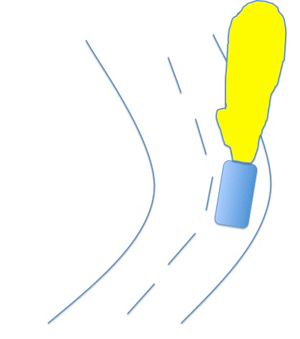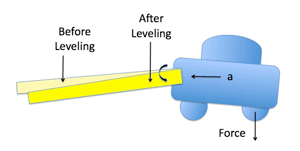Adaptive front lighting systems adjust the illumination from a vehicle's head lamps to compensate for various driving situations. Most adaptive front lighting systems have one or more of the following features:
- The aim of the head lamps adjusts to follow curves in the road.
- The beam pattern is altered at intersections depending on the intended direction.
- High-beam/low-beam changes are made automatically in response to rain, fog, oncoming traffic, etc.
Many systems use stepper motors to physically adjust the aim of the headlights. Some systems illuminate new sources of light at different focal points of the head lamp reflector to adjust the beam.
Cornering Lights
Adaptive front head lamp systems use cornering lights to increase the horizontal area that is illuminated by vehicle headlights when turning a corner. There are static cornering lights and dynamic cornering lights.
Static cornering lights employ additional light sources or additional reflectors in the head lamp to direct light to the vehicle's turning direction.

Diagram of vehicle turning to the left with cornering lights. Additional reflector or additional light source shines light in turning direction.
With dynamic cornering lights, the entire head lamp component swivels horizontally when the car goes around a corner. The speed and angle of swiveling is determined by an electronic control unit that gathers information from the vehicle speed sensor, steering wheel position sensor, and yaw rate sensor.


Left: Vehicle with no cornering lights. Right: Vehicle with dynamic cornering lights.
Automatic Head lamp Leveling Control
Automatic head lamp leveling control adds another degree of freedom to front adaptive head lamp systems. Sometimes vertical leveling is needed for the head lamps when weight is distributed unevenly in the car, when the vehicle is accelerating/braking, or when traveling across bumpy terrain. An automatic head lamp leveling control provides appropriate lighting for these situations using stepper motors attached to the head lamp assembly. There are static and dynamic systems.
Static systems only correct for the weight distribution in a vehicle. It calculates the vehicle tilt angle using information provided by vehicle axle sensors and adjusts the head lamp to match the vehicle tilt angle.

Left: Low beam with evenly distributed weight. Right: Low beam adjusted when center of gravity moves to rear of vehicle.
Dynamic systems account for both weight distribution and accelerating/braking changes.

Low beam adjusted for vehicle acceleration.
Light Camera
Some adaptive front lighting systems employ a CMOS color camera that detects the position of light sources and an ECU that determines the types of light sources detected. Light sources determined to originate from an approaching vehicle will switch your vehicle head lamps to low beam as the approaching vehicle passes and then switch the head lamps back to the high beam position. This reduces glare for the other driver and creates a safer driving environment for both drivers. The color camera also detects when a vehicle merges in front of your lane and switches the head lamps to low beam position. As the other car speeds up, your head lamps are appropriately adjusted until the full high beam position is reached. The color camera can also detect fog and tunnels and adjust the head lamps accordingly. This camera is typically mounted under the windshield above the rear-view mirror.
Adjustable High Beams
In the past, most cars have had two front light settings: low and high. In some of today's high end cars, the high-beams are controlled by the adaptive front lighting system in order to provide a continuous range of light intensity from a low-beam level to a full high-beam level. The headlights can also be adjusted vertically. When in traffic, the low-beams are aimed lower to prevent glare for other drivers. When no other cars are detected, the high-beams are aimed higher to shine farther down the road. These lights are normally controlled by a camera, as described in the "Light Camera" section above.
Laser and LED Headlight Systems
The introduction of LED and laser headlight technology has enabled the development of sophisticated headlight systems that can selectively avoid certain areas (e.g. the windshield of an oncoming car) or selectively highlight certain areas (e.g. pedestrians or animals). These systems can also adjust the brightness and focus of the headlights based on vehicle speed and other factors. While adaptive headlight systems with these capabilities are available on select models outside the U.S., NHTSA regulations governing the design of headlights currently prohibit these systems from being introduced to the U.S. market.

